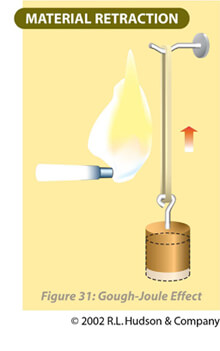Rubber-Lexicon
Gough-Joule Effect
Most solid and gaseous materials expand when heated. Elastomers under tension are an exception. These contract when heated. The phenomenon was first discovered in 1802 by the English scientist John Gough on natural rubber and was investigated in more detail by James Prescott Joule in the 1850s. Hence the name Gough-Joule effect.
The reason for the Gough-Joule effect is the tendency of stretched elastomer polymer chains to return to their original shape when heated.
The Gough-Joule effect is of technical importance, for example, in the design of rotating sealing systems with O-rings. If an O-ring mounted under preload is heated during use, it contracts. This can lead to geometric deformation or even breakage of the O-ring. This phenomenon can be countered by designing the O-ring to be 2 – 5% larger than the rotating shaft to be sealed. If the elastomer is not under tension, the described Gough-Joule effect does not occur.
